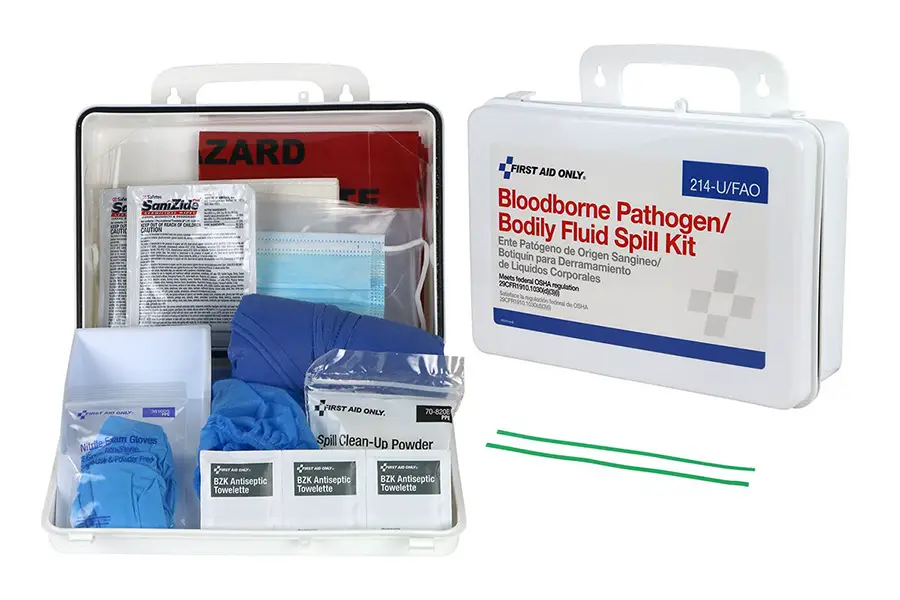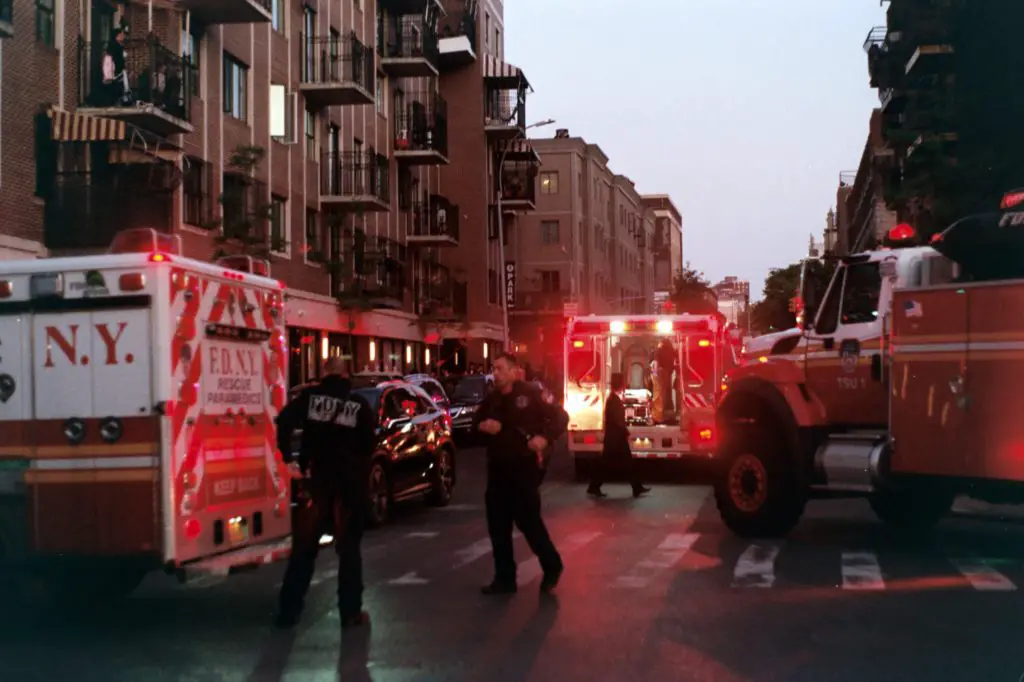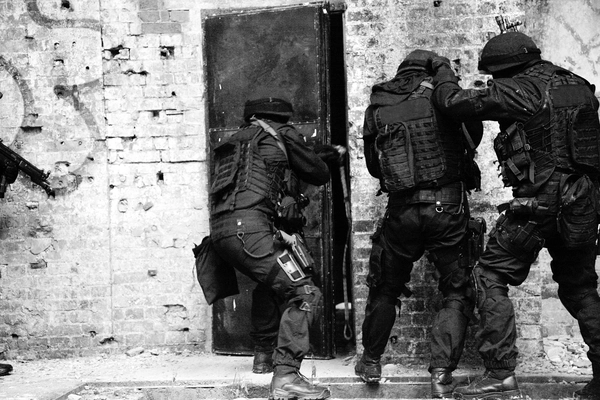Did you know that human blood is considered a biohazard? Bloodborne pathogens could be living in the blood and pose a serious health threat to workers. That’s why the Occupational Safety and Health Administration (OSHA) has created safety standards to keep employees safe. Although you might only think of blood in a medical occupation, OSHA standards aren’t just for workers in the medical fields; many workers outside of the medical field could be exposed. These standards include the use of bloodborne pathogen kits to protect employees from exposure to infectious diseases.
This article will explain what bloodborne pathogen kits are, why they are needed, and other aspects of OSHA’s standards that pertain to blood and bodily fluids.
What are bloodborne pathogens?
Bloodborne pathogens are any germ or organism that lives within a person’s bloodstream. They may be transmitted by any substance that contains blood, as well as other bodily fluids, human tissue, or organs. These pathogens cause disease in humans.
What are the most common blood borne pathogens?
- Hepatitis B: Hepatitis B affects the liver and has a vaccine
- Hepatitis C: Hepatitis C also affects the liver but has no vaccine
- HIV: The human immunodeficiency virus which compromises the immune system and can lead to AIDS
Why are bloodborne pathogen kits needed?
BBP kits are needed to comply with the Needlestick Safety and Prevention Act of 2000 and OSHA standard 1910.1030 Bloodborne Pathogens, which prescribes safeguards to protect workers against the health hazards caused by bloodborne pathogens. The act has requirements that address items such as:
- Creating an exposure control plan
- Application of universal precautions, meaning that all human blood and some bodily fluids are to be considered infectious
- Engineering controls (tools used to keep the workplace safer)
- Work practice controls (minimize exposure by setting standards and procedures)
- Personal protective equipment
- Housekeeping
- Laboratories
- Hepatitis B vaccinations
- Post-exposure follow-up
- Hazard communication and training
- Recordkeeping and training records
Not all employers need to worry about everything listed above! These standards apply to workplaces where occupational exposure is reasonably anticipated as part of an employee’s duties. BBP kits provide the PPE and engineering controls to clean up material that could contain infectious. They are typically an easy-to-grab package located near a first aid kit.
Does OSHA require a bloodborne pathogen kit?
Yes, OSHA requires that a BBP kit is readily available to any and all employees who work in an environment where exposure to bloodborne pathogens is likely. Employees must complete training provided by the employer to reduce that employee’s risk of exposure.
The OSHA standard specifically states that the standard does not apply to agriculture or construction jobs in a series of interpretations made in 1993.
Bloodborne pathogen kits for non-medical occupations
You might think that because you’re not in a medical setting, you don’t need to comply with the BBP requirements. The fact is that some professions still have some chance of dealing with blood or potentially contaminated materials. For example, a coach for a sports team has first aid training and will be the most likely person to respond to an injury during a game or practice. Since the coach is designated as a first aid provider, they would need to be trained and have access to a BBP kit. Other occupations where you are likely to need a BBP kit are:
- Commercial kitchens due to the use of knives, slicers, etc.
- Barber shops / salons
- Housekeepers, especially given the chance of finding used needles in hotel rooms
- Nail salons
- Custodians
- Tattoo artists
As the example of the coach suggests, the standard also applies to anyone in employment who is trained and designated as a first-aid renderer, although there is an exception to the requirements regarding the hepatitis B vaccine.
In the case of “good samaritan” situations (meaning when a non-medically trained person provides first aid in a non-medical environment), that is not a situation where an employer would have been expected to comply with the Act. OSHA gives the example of one employee assisting another employee with a nose bleed. See OSHA’s clarification of the good samaritan scenario here.
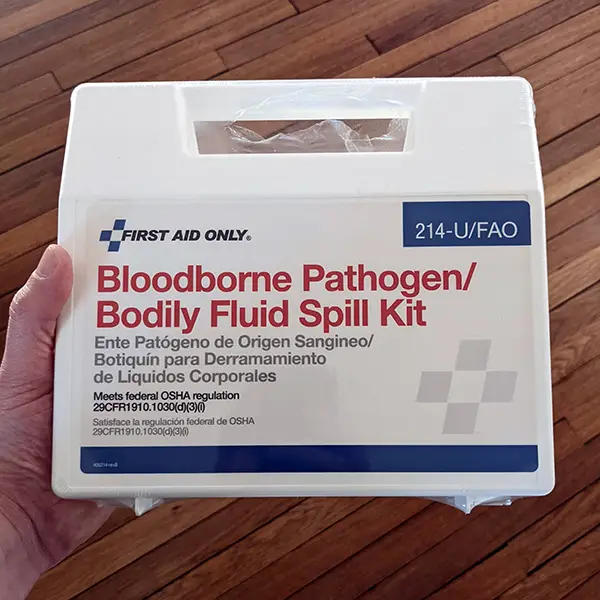
What are bloodborne pathogen kits used for?
BBP kits contain the personal protective equipment (PPE) necessary to safeguard an employee from material that may be infected with bloodborne pathogens. They also contain tools to clean up a spill and dispose of it safely. Per OSHA’s description of “universal precautions,” it’s best to assume that all foreign bodily fluids may contain BBPs, so the proper precautions should be made.
The BBP standards apply to:
- Blood
- Semen
- Vaginal Secretions
- Cerebrospinal, synovial, pleural, pericardial, peritoneal, and amniotic fluids
- Saliva in dental procedures
- Any bodily fluid that is visually contaminated with blood
- All body fluids in situations where it is difficult or impossible to differentiate between body fluids
Of course, a BBP kit is a good way to clean up other bodily fluid spills such as vomit or urine.
Bloodborne pathogen kit requirements
OSHA gives specific examples of the types of PPE that an employer may be required to provide, depending on the chance and possible extent of occupational exposure. It doesn’t state that a “kit” is necessary, only that the necessary tools are readily available. However, a BBP kit is a sure-fire way to comply with the standard and is easy to show in the event of an inspection.
OSHA section 1910.1030(d)(3)(i) states:
“When there is occupational exposure, the employer shall provide, at no cost to the employee, appropriate personal protective equipment such as, but not limited to, gloves, gowns, laboratory coats, face shields or masks and eye protection, and mouthpieces, resuscitation bags, pocket masks, or other ventilation devices. Personal protective equipment will be considered “appropriate” only if it does not permit blood or other potentially infectious materials to pass through to or reach the employee’s work clothes, street clothes, undergarments, skin, eyes, mouth, or other mucous membranes under normal conditions of use and for the duration of time which the protective equipment will be used.“
As you can see, the OSHA standard specifically includes the following required PPE:
- Disposable gloves
- Masks, eye protection and face shields
- Gowns, aprons, and other protective body clothing
- Surgical caps or hoods and/or shoe covers or boots where gross contamination can be reasonably anticipated
Bloodborne pathogens kit contents
BBP kits will typically contain the PPE listed above, tools to assist in the cleaning up of spills, and bags for collection and disposal of the spilled materials. A BBP kit typically contains:
- Personal Protective Equipment including:
- Gloves
- Face Shields
- Gowns
- Face Masks
- Bonnet
- Eye protection
- Shoe Covers
- Biohazard bag and twist tie
- Biohazard scoop
- Disposable absorbent towels
- Plastic bags
- Antiseptic towelettes
- Germicidal wipes
- Spill cleanup powder
BBP kits are considered disposable and one-time use in order to prevent the chance of cross-contamination.
Bloodborne pathogen post exposure protocol
If a needlestick or other BBP incident occurs, the CDC recommends you immediately take the following steps:
- Wash the needlestick and/or cuts with soap and water
- Flush splashes to the nose, mouth, or skin with water
- Irrigate eyes with clean water, saline, or sterile irrigants
- Report the incident to your supervisor
- Immediately seek medical treatment
Source: <https://www.cdc.gov/niosh/topics/bbp/emergnedl.html>
Remember that contact does not always equal illness.
Once a report of an exposure incident is made, the employer shall make a confidential medical evaluation and follow-up immediately available to the exposed employee, including at least the following elements:
- Documentation of the route(s) of exposure
- Identification and documentation of the source individual
- The source individual’s blood shall be tested as soon as feasible and after consent is obtained in order to determine HBV and HIV infectivity. If the source individual is already known to be infected, this step is not necessary.
- Results of the testing shall be made available to the exposed employee
These steps should be explained and expanded upon in the employer’s exposure control plan.
Bloodborne pathogen training kit
BBP training is a requirement of the OSHA standard and all employees who have occupational exposure must receive training. The training needs to be conducted when the employee is hired, annually afterwards, and when changes are made to the standard or the exposure control plan. The training does not require a practical element, meaning that trainees are not required to physically perform any tasks to complete the training. Therefore, no BBP training kit is required, unless the employer chooses to use one for demonstration purposes. What is required is the explanation of the proper use of PPE and the correct procedures for removing and disposing of the PPE.
OSHA states that: “The employer shall train each employee with occupational exposure in accordance with the requirements of this section. Such training must be provided at no cost to the employee and during working hours. The employer shall institute a training program and ensure employee participation in the program.”
Per OSHA requirements, the training needs to cover:
- An explanation of the OSHA bloodborne pathogen standard
- A description of bloodborne diseases and their symptoms
- Explain how bloodborne diseases might be transferred
- Provide a copy and explanation of the employer’s exposure control plan
- Recognize the tasks that may involve exposure
- Discuss the methods of reducing exposure and their limitations
- Proper use, handling, and disposal/cleaning of PPE
- How to select the proper PPE
- Information about the hepatitis B vaccine and how to obtain it
- What to do in a BBP incident
- How to report an incident and obtain a medical follow-up
- Provide an explanation of labels, color coding, or signs associated with BBPs, biohazards, etc.
- Give an opportunity for trainees to ask questions
Frequently asked questions regarding BBP kits
Who needs a bloodborne pathogen kit?
A bloodborne pathogen kit is required by anyone who could be exposed to bloodborne pathogens at work. This includes healthcare workers, doctors, nurses, and dentists, but extends to occupations outside of the medical field. See bloodborne pathogen kits for non-medical occupations.
Is a bloodborne pathogen kit the same as a first aid kit?
No, BBP kits only include personal protective equipment and tools to assist in the cleanup of spills that may contain bloodborne pathogens. They do not contain any of your typical first aid items like bandages, gauze, etc.
Is a bloodborne pathogen kit the same as a spill clean up kit?
A spill kit is typically a simplified version of a BBP kit that contains less PPE. OSHA says to provide the “appropriate personal protective equipment“, and spill kits (aka bodily fluid cleanup kits) may be more appropriate for places like offices or retail locations. These locations are where the chance of encountering blood is minimal and where the kits are more likely to be used to clean up bodily fluids like vomit or feces.
Do blood borne pathogen kits expire? How long are they good for?
Yes, bloodborne pathogens do expire. Their shelf life is usually between 1-5 years. This is because some of the contents, like antiseptic towelettes or germicidal wipes, have expiration dates. Even if a date isn’t listed on the outside of the package, there may be dates on the individual components within the kit. In any case, you can always swap out the components that are expired with new ones.
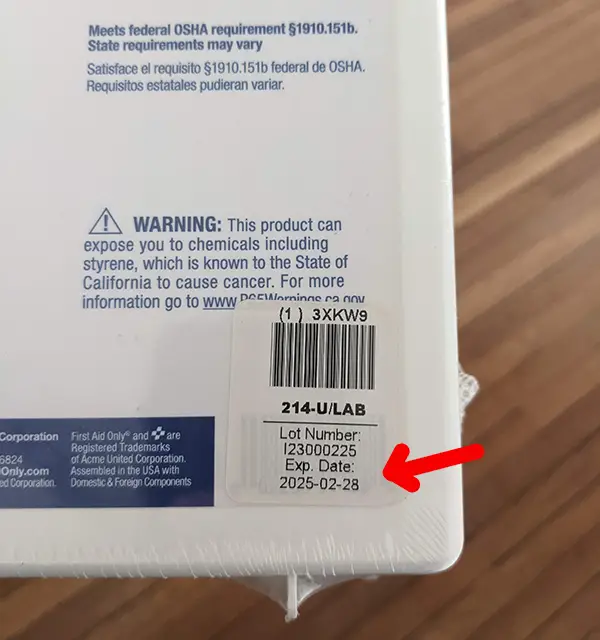
Complying with the standard
OSHA regulations can feel overwhelming and complicated at times, and hopefully, this article was able to help. OSHA does offer voluntary on-site consultations to assist you with complying with any and all of their standards. You can reach out to your local OSHA consultation program to set one up. Also, don’t forget to review your state’s regulations. OSHA standards are set at the federal level and your state may have more stringent requirements.
Sources:
https://www.osha.gov/laws-regs/regulations/standardnumber/1910/1910.1030
https://www.osha.gov/bloodborne-pathogens/quick-reference
https://www.osha.gov/laws-regs/standardinterpretations/1993-02-01-0
https://www.osha.gov/laws-regs/standardinterpretations/1993-02-01-0
Cover Image: https://www.firstaidonly.com/wall-mount-blood-borne-pathogen-bbp-and-bodily-fluid-spill-kit-in-plastic-carry-case-osha-24-pieces-white.html
Have you had to use a BBP kit before? Do you have to comply with the BBP OSHA requirements? Tell us your experience below.

